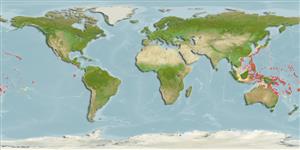Environment / Climate / Range
Ecology
Marine; reef-associated; depth range 4 - 30 m (Ref. 90102). Tropical, preferred ?
Western Pacific: Philippines and Taiwan to Fiji, north to the Izu Islands, south to the Great Barrier Reef and New Caledonia. Recently recorded from Tonga (Ref. 53797).
Size / Weight / Age
Maturity: Lm ? range ? - ? cm
Max length : 20.0 cm SL male/unsexed; (Ref. 9823)
Dorsal
spines
(total): 9;
Dorsal
soft rays
(total): 11-13;
Anal
spines: 3;
Anal
soft rays: 11 - 13. Head spotted. Color of females black dorsally, blue spotted, becoming yellowish white on sides and white ventrally; opercle with a large black ocellus; anal fin with a broad black band. Male form blackish dorsally with light blue dots, shading gradually to light yellowish green; each body scale with vertical light blue line; upper half of head dark reddish with dark-edged blue bands radiating from eye; anal fins with several longitudinal bands on a broad orange zone; caudal fin with vertical stripes. Dorsal spines pungent.
An inshore species inhabiting shallow coral reefs (Ref. 9823), with patches of sand and rubble (Ref. 37816), also along upper part of slopes and on reef crests with Acropora corals. Adults occur in small loose groups of females with dominant male nearby. Juveniles occur solitary in corals (Ref. 48636). Feed on benthic invertebrates. Oviparous, distinct pairing during breeding (Ref. 205). Occasionally seen in fish markets and aquarium trade.
Life cycle and mating behavior
Maturity | Reproduction | Spawning | Eggs | Fecundity | Larvae
Oviparous, distinct pairing during breeding (Ref. 205).
Westneat, M.W., 2001. Labridae. Wrasses, hogfishes, razorfishes, corises, tuskfishes. p. 3381-3467. In K.E. Carpenter and V. Niem (eds.) FAO species identification guide for fishery purposes. The living marine resources of the Western Central Pacific. Vol. 6. Bony fishes part 4 (Labridae to Latimeriidae), estuarine crocodiles. FAO, Rome. (Ref. 9823)
IUCN Red List Status (Ref. 115185)
CITES (Ref. 94142)
Not Evaluated
Threat to humans
Harmless
Human uses
Fisheries: minor commercial; aquarium: commercial
More information
ReferencesAquacultureAquaculture profileStrainsGeneticsAllele frequenciesHeritabilityDiseasesProcessingMass conversion
Tools
Special reports
Download XML
Internet sources
